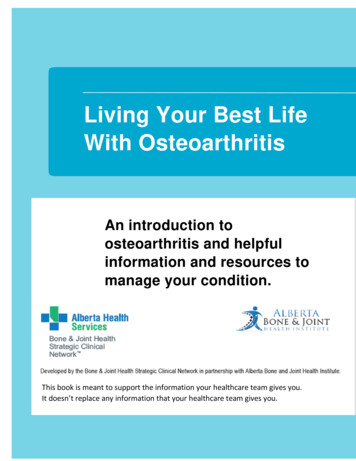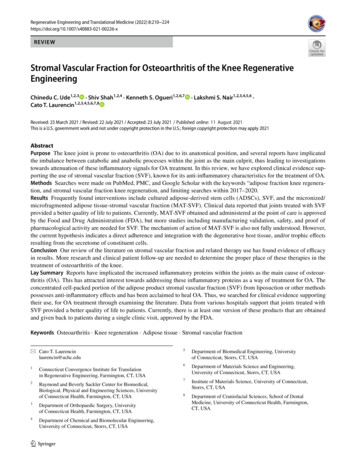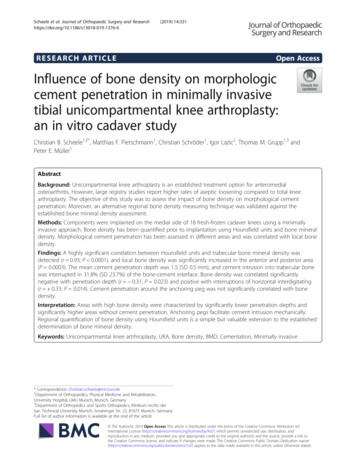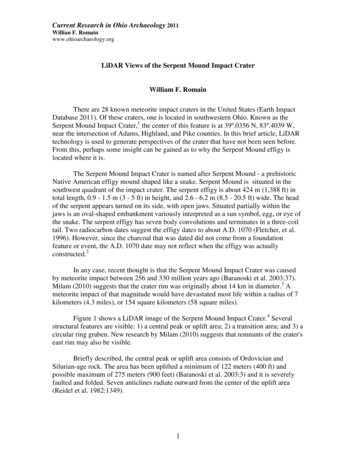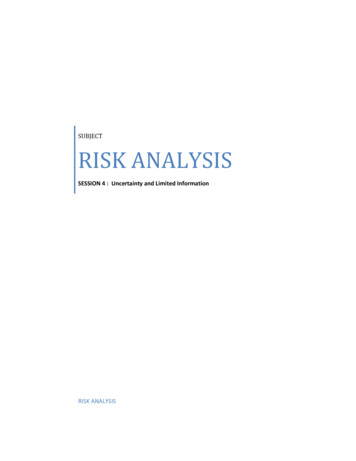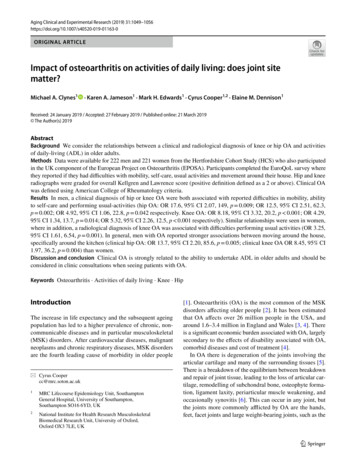
Transcription
Aging Clinical and Experimental Research (2019) 1163-0ORIGINAL ARTICLEImpact of osteoarthritis on activities of daily living: does joint sitematter?Michael A. Clynes1· Karen A. Jameson1 · Mark H. Edwards1 · Cyrus Cooper1,2 · Elaine M. Dennison1Received: 24 January 2019 / Accepted: 27 February 2019 / Published online: 21 March 2019 The Author(s) 2019AbstractBackground We consider the relationships between a clinical and radiological diagnosis of knee or hip OA and activitiesof daily-living (ADL) in older adults.Methods Data were available for 222 men and 221 women from the Hertfordshire Cohort Study (HCS) who also participatedin the UK component of the European Project on Osteoarthritis (EPOSA). Participants completed the EuroQoL survey wherethey reported if they had difficulties with mobility, self-care, usual activities and movement around their house. Hip and kneeradiographs were graded for overall Kellgren and Lawrence score (positive definition defined as a 2 or above). Clinical OAwas defined using American College of Rheumatology criteria.Results In men, a clinical diagnosis of hip or knee OA were both associated with reported difficulties in mobility, abilityto self-care and performing usual-activities (hip OA: OR 17.6, 95% CI 2.07, 149, p 0.009; OR 12.5, 95% CI 2.51, 62.3,p 0.002; OR 4.92, 95% CI 1.06, 22.8, p 0.042 respectively. Knee OA: OR 8.18, 95% CI 3.32, 20.2, p 0.001; OR 4.29,95% CI 1.34, 13.7, p 0.014; OR 5.32, 95% CI 2.26, 12.5, p 0.001 respectively). Similar relationships were seen in women,where in addition, a radiological diagnosis of knee OA was associated with difficulties performing usual activities (OR 3.25,95% CI 1.61, 6.54, p 0.001). In general, men with OA reported stronger associations between moving around the house,specifically around the kitchen (clinical hip OA: OR 13.7, 95% CI 2.20, 85.6, p 0.005; clinical knee OA OR 8.45, 95% CI1.97, 36.2, p 0.004) than women.Discussion and conclusion Clinical OA is strongly related to the ability to undertake ADL in older adults and should beconsidered in clinic consultations when seeing patients with OA.Keywords Osteoarthritis · Activities of daily living · Knee · HipIntroductionThe increase in life expectancy and the subsequent ageingpopulation has led to a higher prevalence of chronic, noncommunicable diseases and in particular musculoskeletal(MSK) disorders. After cardiovascular diseases, malignantneoplasms and chronic respiratory diseases, MSK disordersare the fourth leading cause of morbidity in older people* Cyrus Coopercc@mrc.soton.ac.uk1MRC Lifecourse Epidemiology Unit, SouthamptonGeneral Hospital, University of Southampton,Southampton SO16 6YD, UK2National Institute for Health Research MusculoskeletalBiomedical Research Unit, University of Oxford,Oxford OX3 7LE, UK[1]. Osteoarthritis (OA) is the most common of the MSKdisorders affecting older people [2]. It has been estimatedthat OA affects over 26 million people in the USA, andaround 1.6–3.4 million in England and Wales [3, 4]. Thereis a significant economic burden associated with OA, largelysecondary to the effects of disability associated with OA,comorbid diseases and cost of treatment [4].In OA there is degeneration of the joints involving thearticular cartilage and many of the surrounding tissues [5].There is a breakdown of the equilibrium between breakdownand repair of joint tissue, leading to the loss of articular cartilage, remodelling of subchondral bone, osteophyte formation, ligament laxity, periarticular muscle weakening, andoccasionally synovitis [6]. This can occur in any joint, butthe joints more commonly afflicted by OA are the hands,feet, facet joints and large weight-bearing joints, such as the13Vol.:(0123456789)
1050knees and hips [5]. Joint degeneration in OA results in pain,which in turn leads to stiffness and restricted movement.Epidemiological studies of OA have principally definedOA using two methods: radiographic and clinical [7, 8]. Aradiographic definition of OA captures the structural changesin the joints of interest. The majority of studies employ theradiographic technique first proposed by Kellgren and Lawrence [9], which characterises knee OA into five grades (0,normal to 4, severe) with a score of 2 or above representingOA. A radiological diagnosis of OA alone, however, may notaccurately reflect the clinical burden of the disease as studieshave shown that pain in OA is heightened by co-morbid illness, muscle-strength, mood, cognition and disability [10].An alternative method of defining OA is to utilise clinicalcriteria. In the early 1990s, the American Rheumatism Association (ACR) developed a definition of OA that takes intoaccount medical history, laboratory test results and physicalexaminations.OA can contribute to inactivity with ageing, secondary topain and reduced function, thus ultimately impairing qualityof life. It is well established that OA pain, swelling or stiffness can make it difficult for individuals to perform simpleactivities of daily living (ADL) such as opening boxes offood, tucking in bedsheets, writing, using a computer mouse,driving a car, walking, climbing stairs and lifting objects[11] but to our knowledge the impact the condition has oneveryday function has been little studied in individuals whoare not awaiting joint replacement surgery.The EuroQol survey is a standardized instrument formeasuring generic health status developed in 1990 bythe EuroQol group which is a multidisciplinary team ofresearchers from five European countries; The Netherlands,UK, Sweden, Finland, and Norway [12]. Their aim was todevelop an instrument which is not specific to disease butstandardized and can be used as a complement for existing health-related quality of life (HRQoL) measures. In thecurrent study, we use components of the Euroqol survey toconsider the relationships between a clinical or radiologicaldiagnoses of lower limb OA and ADL in older men andwomen.MethodsThe study participants were 222 men and 221 women fromthe Hertfordshire Cohort Study (HCS) who also participatedin the UK component of the European Project on Osteoarthritis (EPOSA). The Hertfordshire Cohort Study (HCS) isa population-based UK cohort of older adults. Study designand recruitment have been described in detail previously[13]. In brief, we traced men and women born between1931 and 1939 in Hertfordshire and who still lived therein 1998–2003. A nurse-administered questionnaire, which13Aging Clinical and Experimental Research (2019) 31:1049–1056included details of socioeconomic status and dietary calciumintake, was conducted at this time. In a follow-up study in2011–2012, 443 participants consented to a home visit bya trained research nurse. At this visit a nurse-administeredquestionnaire was again administered which included detailsof smoking status, alcohol consumption and physical activity(average minutes per day spent walking, cycling, gardening, playing sport and doing housework in the last 2 weeks).Height was measured to the nearest 0.1 cm and weight to thenearest 0.1 kg on a SECA floor scale (Chasmors Ltd, London, UK). Body mass index (BMI) was calculated as weightdivided by height2 (kg/m2). Participants also answered questions taken from the EuroQol study where they were asked:“Do you have problems with mobility?”; “Do you have problems with self-care?”; “Do you have problems undertakingyour usual activities?” [12]. Participants were then askedmore detailed questions on mobility where they were asked:“Do you have problems moving around inside and outsideyour house?”; “Do you have problems moving around yourbathroom?”; “Do you have problems moving around yourkitchen?”; “Do you have problems moving around your toilet?”; “Do you have problems accessing public facilities suchas grocery shops, bus stops or banks?”. Radiographs weretaken of the hip and knees under standardised conditions ata local hospital after the home visit. Clinical OA was definedbased on algorithms developed by the American College ofRheumatology [14].A clinical diagnosis of hip OA was made if pain, asassessed by WOMAC, was present in addition to all of thefollowing: (1) pain associated with hip internal rotation in atleast one side; (2) morning stiffness lasting 60 min evaluated by the WOMAC stiffness subscale (score from ‘mild’to ‘extreme’); and (3) age of over 50 years [15]. Pain wasassessed using the Western Ontario and McMaster Universities OA Index (WOMAC) pain subscale score. TheWOMAC is a 24-item questionnaire with three subscalesmeasuring pain (five items), stiffness (two items), and physical function (17 items) [16].To diagnose clinical knee OA the patient had to experience knee pain and any three of the following: (1) bonytenderness in at least one side on examination; (2) crepituson active motion in at least one side on examination; (3) lessthan 30 min of morning stiffness, evaluated by the WOMACstiffness subscale; (4) no palpable warmth of synovium inboth knees on examination; (5) age over 50 years; or (6)bony enlargement in at least one side on examination.Radiographs were graded according to Kellgren and Lawrence (KL). KL classifies OA into five grades (0, normalto 4, severe). The KL grading system is briefly describedas follows: grade 0—no radiographic features of OA arepresent; grade 1—unlikely narrowing of the joint space andpossible osteophytes on the radiograph; grade 2—smallosteophytes and possible narrowing of the joint space; grade
Aging Clinical and Experimental Research (2019) 31:1049–10563—multiple, moderately sized osteophytes, definite jointspace narrowing, some sclerotic areas and possible deformation of bone ends; and grade 4—multiple large osteophytes,severe joint space narrowing, marked sclerosis and definitebony end deformity [9]. In our study, a positive definitionof OA reflected a KL score of 2 or above. The radiographswere all graded by two experienced rheumatologists withgood inter-observer agreement.Stata version 14 was used for all analyses. Study participants’ characteristics were summarised using means andstandard deviations (SD) or medians and interquartile ranges(IQR) for continuous variables, and numbers and percentages for binary and categorical variables. Logistic regressionwas used to model the association between self-reported OA,clinical OA and radiographic OA with the components ofthe EuroQol survey and questions on mobility. These analyses were completed with and without adjustment for age,BMI, social class, activity, alcohol intake, baseline dietarycalcium and smoking status and years since menopause andHRT use in women. These confounders were selected asthey have been shown to be associated with the ability toundertake ADL and OA in previous studies. A study byPollard and colleagues on a cohort of 763 people who hadbeen diagnosed with OA in Somerset and Avon, UK showedthat impact of OA on ADL appears to vary with respect tosocial deprivation [17]. A recent study by Magnusson andcolleagues showed alcohol was associated with inflammatory hand OA whereas smoking appeared to be protective[18]. Farr et al. have demonstrated using accelerometry thatthe majority of patients with knee OA do not meet the recommended levels of physical activity [19] which results in1051weight gain and obesity, progression of OA and impairmentof function [20]. Finally, significantly higher concentrationsof calcium have been found in the meniscus of individualswith knee OA undergoing total knee replacement surgery[21].ResultsThe mean [standard deviation (SD)] age of study participants was 75.5 (2.5) and 75.8 (2.6) years in men and women,respectively. The mean body mass index (BMI) was 27.9 kg/m2 (SD 3.9) in men and 28.4 kg/m2 (SD 5.1) in women.Men had a lower median activity time than women in thelast 2 weeks [176 min/day (IQR 105–270) and 200 min/day(IQR 135–283) respectively], although this did not reachstatistical significance (p 0.089). A higher proportion ofmen were current smokers [5% (n 11) vs 2.7% (n 6) ofwomen] (Table 1).Seven (3.2%) men and 13 (6.0%) women had a clinicaldiagnosis of hip OA. Radiographic hip OA was more common, affecting 46.3% (n 93) of men and 40.6% (n 78) ofwomen. Knee OA was overall more common than hip OA inboth sexes with the radiographic diagnosis again being moreprevalent [50.2% (n 101) of men and 58.7% (n 118) ofwomen], compared with the clinical diagnosis [12% (n 26)of men and 19% (n 41) of women] (Table 1).In men, a clinical diagnosis of hip or of knee OA wereboth associated with reported difficulties in mobility, ability to self-care and performing usual activities (hip OA:OR 17.6, 95% CI 2.07, 149, p 0.009; OR 12.5, 95%Table 1 Participant demographicsMenAge (years)Height (cm)BMI (kg/m2)Activity time in last 2 weeks (min/day)Daily dietary calcium intake (mg)Alcohol consumption (units/week)Clinical OAHipKneeRadiographic OAHipKneeWomennMean (SD)nMean (SD)22222122175.5 (2.5)172.7 (6.5)27.9 (3.9)22121721775.8 (2.6)158.8 (6.1)28.4 (5.1)nMedian (IQR)nMedian (IQR)205222222176 (105–270)1221 (1021–1432)6.5 (1.0–14.0)200221221200 (135–283)1105 (939–1281)0.5 (0.0–3.5)Total nn (%)Total nn%2192167 (3.2)26 (12.0)21621613 (6.0)41 (19.0)20120193 (46.3)101 (50.2)19220178 (40.6)118 (58.8)13
1052Aging Clinical and Experimental Research (2019) 31:1049–1056CI 2.51, 62.3, p 0.002; OR 4.92, 95% CI 1.06, 22.8,p 0.042, respectively. Knee OA: OR 8.18, 95% CI 3.32,20.2, p 0.001; OR 4.29, 95% CI 1.34, 13.7, p 0.014; OR5.32, 95% CI 2.26, 12.5, p 0.001 respectively). With theexception of the association between clinical knee OA andself-care these findings remained robust following adjustment for confounders (Table 2). Very similar relationshipswere seen in women, where clinical OA at hip and kneewere both associated with reported difficulties in mobility, ability to self-care and performing usual activities (HipOA: OR 5.49, 95% CI 1.63, 18.5, p 0.006; OR 8.81, 95%CI 2.67, 29.0, p 0.001 and OR 15.9, 95% CI 3.40, 74.0,p 0.001 respectively; Knee OA: OR 7.51, 95% CI 3.56,15.9, p 0.001; OR 9.52, 95% CI 3.87, 23.4, p 0.001 andOR 9.20, 95% CI 4.31, 19.7, p 0.001, respectively). Theassociation between clinical knee OA and difficulties withmobility, self-care and performing usual activates remainedrobust following adjustment for confounders but for clinical hip OA only the association with problems performingusual activities remained significant following adjustmentfor confounders (OR 19.6, 95% CI 1.18, 326, p 0.038).Additionally, in women a radiological diagnosis of knee OAwas associated with similar, though less marked, reporteddifficulties in mobility, self-care and performing usual activities (OR 2.56, 95% CI 1.36, 4.85, p 0.004; OR 2.81, 95%CI 1.00, 7.90, p 0.050 and OR 3.25, 95% CI 1.61, 6.54,p 0.001 respectively). Aside from the association with selfcare these associations remained robust following adjustment for confounders (Table 3).In general, men reported stronger associations betweenOA and moving around the house than women. In men thereTable 2 Hip and knee OAas explanatory variables forEuroQoL scores in menwas a significant association with problems moving aroundinside and outside the house and a clinical diagnosis of OAat the hip or the knee (OR 14.4, 95% CI 2.98, 69.3, p 0.001and OR 7.85, 95% CI 2.90, 21.3, p 0.001, respectively) andthis remained robust following adjustment for confounders.Very similar associations with clinical hip and knee OA wereseen when men were asked if they had difficulties mobilising around the kitchen specifically (OR 13.7, 95% CI 2.20,85.6, p 0.005 and OR 8.45, 95% CI 1.97, 36.2, p 0.004,respectively) and these findings again remained significantfollowing adjustment for confounders. Furthermore, clinical hip and knee OA in men were positively associated withproblems accessing public facilities (OR 10.4, 95% CI 2.20,49.5, p 0.003 and OR 3.78, 95% CI 1.46, 9.80, p 0.006,respectively) but only clinical hip OA remained significantfollowing adjustment for confounders (OR 108, 95% CI7.69, 1529, p 0.001). Interestingly, following adjustmentfor confounders, knee OA was not associated with problemsmoving around the bathroom or toilet in men but significant associations were seen with both clinical hip OA andradiographic hip OA (bathroom: clinical hip OA—OR 290,95% CI 11.1, 7559, p 0.001 and radiographic hip OA—OR7.71, 95% CI 1.28, 46.4, p 0.026; toilet: clinical hip OA—OR 93.1, 95% CI 5.44, 1593, p 0.002 and radiographichip OA—OR 5.84, 95% CI 1.00, 34.1, p 0.050) (Table 4).Overall, the associations between OA and difficultieswith reported mobility were weaker in women. In contrastto men there was no association between either hip or kneeOA and difficulties accessing public facilities and movingaround the bathroom following adjustment for confounders.Knee, but not hip, OA in women was associated with generalAdjustedaUnadjustedEuroQoL mobilityClinical hip OARadiographic hip OAClinical knee OARadiographic knee OAEuroQoL self-careClinical hip OARadiographic hip OAClinical knee OARadiographic knee OAEuroQoL usual activitiesClinical hip OARadiographic hip OAClinical knee OARadiographic knee OAanOR95% CInOR95% CIp value21920121620117.60.948.181.15(2.07, 149)(0.50, 1.78)(3.32, 20.2)(0.61, 2.16)0.0090.846 0.0010.6611921761881752501.907.810.60(6.45, 9663)(0.83, 4.31)(2.47, 24.8)(0.27, 1.32)0.0030.127 0.0010.20421920121620112.51.684.293.16(2.51, 62.3)(0.51, 5.47)(1.34, 13.7)(0.83, .14(3.86, 499)(0.72, 12.1)(0.56, 9.81)(0.60, .33(1.06, 22.8)(0.41, 1.64)(2.26, 12.5)(0.67, 2.65)0.0420.571 0.0010.42219117518717410.71.163.020.80(1.60, 71.3)(0.50, 2.66)(1.07, 8.49)(0.35, 1.84)0.0150.7300.0360.605Adjusted for age, BMI, social class, smoker status, alcohol consumption, activity and baseline dietary calcium13
Aging Clinical and Experimental Research (2019) 31:1049–1056Table 3 Hip and knee OAas explanatory variables forEuroQoL scores in women1053AdjustedaUnadjustedEuroQoL mobilityClinical hip OARadiographic hip OAClinical knee OARadiographic knee OAEuroQoL self-careClinical hip OARadiographic hip OAClinical knee OARadiographic knee OAEuroQoL usual activitiesClinical hip OARadiographic hip OAClinical knee OARadiographic knee OAnOR95% CIp valuenOR95% CIp value2161922162015.492.057.512.56(1.63, 18.5)(1.11, 3.79)(3.56, 15.9)(1.36, 4.85)0.0060.021 0.0010.0041921701921793.311.956.052.55(0.37, 29.6)(0.90, 4.23)(2.33, 15.71)(1.16, 5.58)0.2840.089 0.0010.0192161922162018.812.339.522.81(2.67, 29.0)(0.94, 5.76)(3.87, 23.4)(1.00, 7.90) 0.0010.066 0.0010.0501921701921797.132.025.492.78(0.88, 57.8)(0.61, 6.68)(1.67, 18.1)(0.69, .25(3.40, 74.0)(0.88, 3.12)(4.31, 19.7)(1.61, 6.54) 0.0010.117 0.0010.00119116919117819.61.298.915.09(1.18, 326)(0.59, 2.86)(3.45, 23.0)(1.99, 13.0)0.0380.524 0.0010.001aAdjusted for age, BMI, social class, smoker status, alcohol consumption, activity, baseline dietary calcium, years since menopause and HRT useproblems moving inside and outside the house followingadjustment for confounders (clinical knee OA: OR 13.5, 95%CI 4.09, 44.7, p 0.001; radiographic knee OA: OR 12.4,95% CI 2.41, 64.0, p 0.003) and problems moving aroundthe kitchen after adjustment for confounders (clinical kneeOA: OR 5.38, 95% CI 1.17, 24.7, p 0.030). Similarly tomen, clinical hip OA was associated with problems movingaround the toilet (OR 12.1, 95% CI 3.34, 43.6, p 0.001) andthis association also remained significant post adjustment forconfounders (Table 5).DiscussionIn the current study, we have shown that a diagnosis oflower limb OA is strongly related to the ability to undertakeADL in older adults. We have demonstrated that in bothmen and women a clinical diagnosis of hip or of knee OAand a radiological diagnosis of knee OA in women is associated with difficulties in mobility, ability to self-care andperforming usual activities. Our data, therefore. suggeststhat using a clinical criteria to diagnose OA, especially inmen, is more sensitive at identifying individuals who are atrisk of functional impairment then employing a radiographicdiagnosis alone. This is consistent with previous studiesthat have shown radiographic knee OA correlates poorlywith the physical symptoms of OA [22]. Indeed, a previous study utilising participants from the HCS demonstratedthat a substantial proportion of men and women who werediagnosed with radiographic OA did not have self-reportedor diagnosis of clinical OA (57.7%) [7]. Our study thereforelends further credence to the argument that in the clinicalsetting where the focus of intervention is on the improvement of symptoms, the use of a clinical definition of kneeOA, which includes pain, may be more useful than relyingon a radiographic diagnosis alone to identify individuals atrisk of functional impairment and target resources accordingly. Indeed, the International Rheumatologic Board (IRB)recently proposed guidelines for the diagnosis of OA in primary care which are based on the ACR criteria for clinicalOA [23].Our data are consistent with previous studies that haveshown that OA leads to impairments in quality of life andADL and as a consequence, results in dependency, institutionalisation and increased health-care costs [24, 25]. Themajority of these studies have been qualitative in nature buta recent study by Stamm and colleagues explored the limitations in the ADLs in older adults in a population-basedsurvey of 3097 subjects aged 65 years in Austria. Theydemonstrated that OA was associated with a with a 68%higher chance of impairment of intense ADLs such as lifting and carrying a shopping bag of over 5 kg of weight,bending and kneeling down, walking 500 m without the useof aids, climbing stairs without the use of aids and heavyhousework [25].We have observed in the current study that problemswith mobilising around specific rooms in the house andaccessing public facilities varied according to site and sex.The ability of men to mobilise around the kitchen and toaccess public facilities was impeded by both hip and kneeOA with stronger associations seen when a clinical definition of OA is utilised. In contrast to men, there was no13
1054Aging Clinical and Experimental Research (2019) 31:1049–1056Table 4 Hip and knee OAas explanatory variables forproblems moving around in menAdjustedaUnadjustednOR95% CIProblems moving around inside and outside houseClinical hip OA219 14.4 (2.98, 69.3)Radiographic hip OA201 1.18 (0.47, 2.97)Clinical knee OA216 7.85 (2.90, 21.3)Radiographic knee OA201 1.79 (0.67, 4.76)Problems moving around bathroomClinical hip OA219 34.0 (6.50, 178)Radiographic hip OA201 2.85 (0.72, 11.4)Clinical knee OA216 6.22 (1.81, 21.4)Radiographic knee OA201 1.52 (0.41, 5.54)Problems moving around kitchenClinical hip OA219 13.7 (2.20, 85.6)Radiographic hip OA201 1.57 (0.34, 7.22)Clinical knee OA216 8.45 (1.97, 36.2)Radiographic knee OA201 2.55 (0.48, 13.5)Problems moving around toiletClinical hip OA219 22.0 (4.11, 117)Radiographic hip OA201 2.41 (0.59, 9.93)Clinical knee OA216 5.58 (1.46, 21.3)Radiographic knee OA201 2.04 (0.50, 8.40)Problems accessing public facilitiesbClinical hip OA219 10.4 (2.20, 49.5)Radiographic hip OA201 0.44 (0.17, 1.10)Clinical knee OA216 3.78 (1.46, 9.80)Radiographic knee OA201 1.20 (0.51, 2.81)p value nOR95% CIp value0.0010.725 0.0010.24219217618817549.01.707.970.77(4.75, 506)(0.54, 5.33)(2.12, 30.0)(0.23, 2.60)0.0010.3600.0020.674 .1, 7559)(1.28, 46.4)(0.96, 23.1)(0.19, 618817563.53.3112.11.56(2.81, 1434)(0.54, 20.3)(1.41, 104)(0.25, 9.93)0.0090.1960.0230.636 .44, 1593)(1.00, 34.1)(0.72, 24.2)(0.33, 61881751080.412.070.44(7.69, 1529)(0.11, 1.55)(0.56, 7.61)(0.12, 1.60)0.0010.1900.2740.212aAdjusted for age, BMI, social class, smoker status, alcohol consumption, activity and baseline dietary calciumbProblems with accessing public facilities such as grocery shops, bus stops or bankssignificant association between lower limb OA and difficulties accessing public facilities or mobilising around thebathroom in women following adjustment for confounders.In both sexes, however, hip OA was associated with difficulties mobilising around the toilet. These results suggest that the specific movements required for mobilisingaround a toilet, which is usually in a confined space, andthe action of getting on and off a toilet are more impededby hip OA than knee OA. Conversely, mobilising aroundtraditionally larger rooms, such as the kitchen, appears tobe more impeded by knee OA. These results are particularly pertinent when considering the benefit of potentiallytailoring occupational therapy (OT) services to differentgroups of patients and that we should ask about ADL inthe clinic setting. Indeed, there is strong evidence to suggest that to successfully design healthcare programs for thetreatment of OA it is essential to consider what patientsneed and prefer, and how they value various aspects of ahealth intervention [26].13Our study is limited in that the results may not be entirelyrepresentative of the wider UK population since all recruitedparticipants were born in the county of Hertfordshire and atage 75 were still living there (as had been the case in previous studies). We have demonstrated that this cohort are agood representation of the general population with regard tobody build and lifestyle factors, such as smoking and alcoholintake, therefore suggesting that selection bias was minimal[27]. Furthermore, all comparisons undertaken were internal. There is a possibility that there may have been someinconsistencies in the interpretation of radiographs. To minimise this risk, however, two experienced rheumatologistswere used to grade the radiographs, with high inter-observerconcordance. We have also previously shown that for bothclinical and radiographic assessment of OA used withinthis current study good levels of agreement exists betweenand within-observer variation. Briefly, repeatability for allobservations was graded either good or excellent by multiple observers [28]. Additionally, only a small number of
Aging Clinical and Experimental Research (2019) 31:1049–1056Table 5 Hip and knee OAas explanatory variables forproblems moving around inwomen1055AdjustedaUnadjustednOR95% CIProblems moving around inside and outside houseClinical hip OA216 6.73 (2.11, 21.4)Radiographic hip OA192 1.84 (0.87, 3.88)Clinical knee OA216 14.7 (6.45, 33.5)Radiographic knee OA201 5.32 (1.97, 14.4)Problems moving around bathroomClinical hip OA216 6.84 (2.01, 23.2)Radiographic hip OA192 1.70 (0.71, 4.08)Clinical knee OA216 7.63 (2.95, 19.7)Radiographic knee OA201 5.44 (1.56, 19.0)Problems moving around kitchenClinical hip OA216 7.30 (2.14, 25.0)Radiographic hip OA192 1.71 (0.69, 4.24)Clinical knee OA216 11.1 (4.09, 30.4)Radiographic knee OA201 4.80 (1.37, 16.9)Problems moving around toiletClinical hip OA216 12.1 (3.34, 43.6)Radiographic hip OA192 1.75 (0.61, 5.03)Clinical knee OA216 13.8 (4.07, 46.8)Radiographic knee OA201 5.01 (1.10, 22.9)Problems accessing public facilities bClinical hip OA216 6.39 (1.98, 20.6)Radiographic hip OA192 2.02 (0.89, 4.60)Clinical knee OA216 7.98 (3.43, 18.6)Radiographic knee OA201 2.22 (0.89, 5.51)p value nOR95% CIp value0.0010.110 0.0010.0011921701921795.322.4313.512.4(0.58, 48.8)(0.82, 7.18)(4.09, 44.7)(2.41, 64.0)0.1390.108 0.0010.0030.0020.233 0.0010.0081921701921797.852.203.494.00(0.75, 82.2)(0.49, 9.83)(0.82, 14.8)(0.66, 24.2)0.0850.3030.0900.1300.0020.249 0.0010.0141921701921797.213.195.383.37(0.59, 87.8)(0.53, 19.1)(1.17, 24.7)(0.47, 24.2)0.1210.2040.0300.227 0.0010.301 0.0010.03719217019217915.72.095.005.24(1.36, 180)(0.44, 9.80)(0.96, 26.1)(0.49, 56.0)0.0270.3510.0560.1710.0020.093 0.0010.0871921701921791.512.233.241.22(0.11, 20.2)(0.58, 8.54)(0.76, 13.9)(0.32, 4.65)0.7560.2420.1130.770aAdjusted for age, BMI, social class, smoker status, alcohol consumption, activity, baseline dietary calcium, years since menopause and HRT usebProblems with accessing public facilities such as grocery shops, bus stops or banksparticipants (7 men and 13 women) fit the diagnostic criteriafor clinical hip OA which may limit our power to detectstatistically significant relationships. Finally, the study population did not specifically exclude individuals who wereawaiting a joint replacement operation and therefore someof these individuals may have been included in the analysis.There is evidence to suggest, however, that although functional improvements following knee arthroplasty are excellent regardless of age, knee arthroplasty contributes littleto the quality of life in older patients (octogenarians) [29].ConclusionsOur study shows that a diagnosis of OA is strongly relatedto the ability to undertake ADL in older adults. Limitations in ADLs and mobility vary according to site and sexand these differences should be considered in the clinicalsetting. These data support the requirement for functionalassessment and corresponding interventions to prevent worsening functional decline in individuals with OA and the consequent health and social problems which would arise atgreat expense to the individual and society.Funding This study was funded by the Porticus foundation.Compliance with ethical standardsConflict of interest Author Michael Clynes has received support forattending conferences from UCB, Pfizer and Eli Lily. Author ElaineDennison has received fees from Pfizer and UCB. Author ProfessorCyrus Cooper has received lecture fees and honoraria from Amgen,Danone, Eli Lilly, GSK, Medtronic, Merck, Nestlé, Novartis, Pfizer,Roche, Servier, Shire, Takeda and UCB outside of the submitted work.Ethical app
to 4, severe). The KL grading system is briefly described as follows: grade 0—no radiographic features of OA are present; grade 1—unlikely narrowing of the joint space and possible osteophytes on the radiograph; grade 2—small osteophytes and possible narrowing of the joint space; grade
